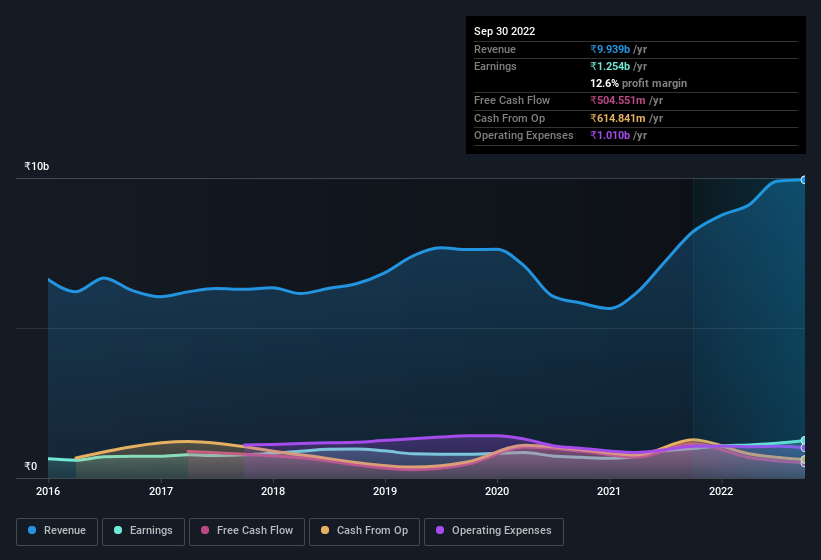Ingersoll-Rand (India)'s (NSE:INGERRAND) Shareholders May Want To Dig Deeper Than Statutory Profit
The market for Ingersoll-Rand (India) Limited's (NSE:INGERRAND) stock was strong after it released a healthy earnings report last week. However, we think that shareholders should be cautious as we found some worrying factors underlying the profit.
Our analysis indicates that INGERRAND is potentially overvalued!

Zooming In On Ingersoll-Rand (India)'s Earnings
In high finance, the key ratio used to measure how well a company converts reported profits into free cash flow (FCF) is the accrual ratio (from cashflow). To get the accrual ratio we first subtract FCF from profit for a period, and then divide that number by the average operating assets for the period. The ratio shows us how much a company's profit exceeds its FCF.
That means a negative accrual ratio is a good thing, because it shows that the company is bringing in more free cash flow than its profit would suggest. That is not intended to imply we should worry about a positive accrual ratio, but it's worth noting where the accrual ratio is rather high. That's because some academic studies have suggested that high accruals ratios tend to lead to lower profit or less profit growth.
Over the twelve months to September 2022, Ingersoll-Rand (India) recorded an accrual ratio of 0.32. Therefore, we know that it's free cashflow was significantly lower than its statutory profit, raising questions about how useful that profit figure really is. Indeed, in the last twelve months it reported free cash flow of ₹505m, which is significantly less than its profit of ₹1.25b. Ingersoll-Rand (India)'s free cash flow actually declined over the last year, but it may bounce back next year, since free cash flow is often more volatile than accounting profits. One positive for Ingersoll-Rand (India) shareholders is that it's accrual ratio was significantly better last year, providing reason to believe that it may return to stronger cash conversion in the future. Shareholders should look for improved cashflow relative to profit in the current year, if that is indeed the case.
Note: we always recommend investors check balance sheet strength. Click here to be taken to our balance sheet analysis of Ingersoll-Rand (India).
Our Take On Ingersoll-Rand (India)'s Profit Performance
As we have made quite clear, we're a bit worried that Ingersoll-Rand (India) didn't back up the last year's profit with free cashflow. As a result, we think it may well be the case that Ingersoll-Rand (India)'s underlying earnings power is lower than its statutory profit. But at least holders can take some solace from the 58% per annum growth in EPS for the last three. The goal of this article has been to assess how well we can rely on the statutory earnings to reflect the company's potential, but there is plenty more to consider. Keep in mind, when it comes to analysing a stock it's worth noting the risks involved. For example, Ingersoll-Rand (India) has 2 warning signs (and 1 which can't be ignored) we think you should know about.
This note has only looked at a single factor that sheds light on the nature of Ingersoll-Rand (India)'s profit. But there are plenty of other ways to inform your opinion of a company. For example, many people consider a high return on equity as an indication of favorable business economics, while others like to 'follow the money' and search out stocks that insiders are buying. So you may wish to see this free collection of companies boasting high return on equity, or this list of stocks that insiders are buying.
New: AI Stock Screener & Alerts
Our new AI Stock Screener scans the market every day to uncover opportunities.
• Dividend Powerhouses (3%+ Yield)
• Undervalued Small Caps with Insider Buying
• High growth Tech and AI Companies
Or build your own from over 50 metrics.
Have feedback on this article? Concerned about the content? Get in touch with us directly. Alternatively, email editorial-team (at) simplywallst.com.
This article by Simply Wall St is general in nature. We provide commentary based on historical data and analyst forecasts only using an unbiased methodology and our articles are not intended to be financial advice. It does not constitute a recommendation to buy or sell any stock, and does not take account of your objectives, or your financial situation. We aim to bring you long-term focused analysis driven by fundamental data. Note that our analysis may not factor in the latest price-sensitive company announcements or qualitative material. Simply Wall St has no position in any stocks mentioned.
About NSEI:INGERRAND
Ingersoll-Rand (India)
Manufactures and sells industrial air compressors and related services in India.
Flawless balance sheet with solid track record.
Market Insights
Community Narratives




